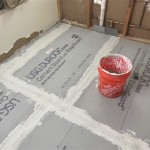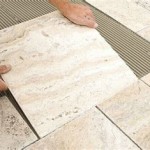Average Cost To Install Ceramic Floor Tile Per Square Foot In Oregon
Installing new ceramic floor tile can significantly enhance the aesthetic appeal and functionality of a home or business. Understanding the costs associated with this type of flooring installation in Oregon is crucial for budgeting and project planning. This article provides a comprehensive overview of the factors influencing the average cost per square foot of ceramic tile installation in the state.
The price of ceramic tile installation is not a fixed number. It is a variable cost that depends on several elements. These elements encompass the type of tile selected, the size and complexity of the installation area, the condition of the existing subfloor, and the labor rates charged by local contractors. Each aspect plays a critical role in determining the final expense of the project.
Ceramic tile remains a popular flooring choice due to its durability, water resistance, and relatively low maintenance requirements. It is suitable for various areas within a home, including kitchens, bathrooms, hallways, and entryways. Unlike some other flooring options, ceramic tile offers a wide range of design possibilities, allowing for customization and personalization. However, the installation process can be labor-intensive and requires skilled professionals to ensure a long-lasting and visually appealing result.
Before delving into the specific cost factors, it is essential to establish a general cost range. In Oregon, the average cost to install ceramic floor tile typically ranges from $8 to $15 per square foot. This range includes both the cost of the tile itself and the labor charges for installation. It is important to note that this is just an average, and the actual cost can vary significantly based on the specific circumstances of each project.
Tile Material Costs
The cost of the ceramic tile itself is a primary factor influencing the overall installation price. Ceramic tiles come in a vast array of styles, sizes, and quality levels. The price per square foot can fluctuate dramatically depending on these factors. Basic, standard-grade ceramic tiles may cost as little as $2 to $4 per square foot. These tiles are often readily available and offer a budget-friendly option for homeowners seeking to update their floors without a significant investment.
Mid-range ceramic tiles, which offer a wider selection of designs, colors, and textures, typically range from $4 to $8 per square foot. These tiles often provide enhanced durability and aesthetic appeal compared to the basic options. They are a popular choice for homeowners who want a balance between affordability and quality.
High-end ceramic tiles, including those with intricate designs, unique finishes, or large formats, can cost upwards of $8 to $20 or more per square foot. These tiles are often imported or manufactured using specialized techniques, contributing to their higher price point. While they represent a more significant investment, they can create a luxurious and distinctive look.
The size of the tile also affects the material cost. Larger tiles generally cost more per square foot than smaller tiles. However, they may require less grout and can sometimes reduce the overall labor cost due to quicker installation times. The choice of tile size should be carefully considered in relation to the size of the room and the desired aesthetic effect.
Furthermore, the type of finish on the tile can influence its cost. Polished or glazed tiles often have a higher price tag than matte or unglazed tiles. Specialty finishes, such as textured or patterned surfaces, can also increase the material cost. The finish should be selected based on the intended use of the space and the desired level of slip resistance.
When budgeting for ceramic tile installation, it is advisable to obtain quotes from multiple tile suppliers to compare prices and explore different options. Consider the long-term value of the tile in terms of durability and maintenance requirements. A slightly more expensive tile that lasts longer and requires less upkeep may ultimately be more cost-effective than a cheaper alternative.
Labor Costs for Installation
Labor costs constitute a significant portion of the total expense of ceramic tile installation. The rates charged by tile installers in Oregon can vary depending on their experience, expertise, and the complexity of the project. Generally, labor costs range from $5 to $10 per square foot. This rate typically includes the preparation of the subfloor, the installation of the tile, and the application of grout.
The condition of the existing subfloor can significantly impact labor costs. If the subfloor is uneven, damaged, or inadequately prepared, additional work may be required to level and reinforce it. This can involve patching cracks, applying self-leveling compound, or installing a new underlayment. These extra steps can add to the overall labor cost.
The complexity of the installation pattern also influences labor costs. Simple, straightforward patterns, such as a basic grid layout, are typically less expensive to install than more intricate patterns, such as herringbone or mosaic designs. Complex patterns require more time, skill, and precision, which translates to higher labor charges.
The size and shape of the room can also affect labor costs. Smaller rooms with many corners and angles tend to be more labor-intensive to tile than larger, more open spaces. Cutting tiles to fit around obstacles, such as pipes or fixtures, also increases the time and effort required for installation.
The experience and licensing of the tile installer can also influence their rates. Licensed and insured contractors typically charge more than unlicensed individuals, but they also offer greater assurance of quality workmanship and protection against liability. It is important to verify the credentials and references of any contractor before hiring them for the job.
To obtain accurate labor cost estimates, it is recommended to get quotes from several qualified tile installers in Oregon. Provide them with detailed information about the project, including the size of the area to be tiled, the type of tile to be used, and the desired installation pattern. Request a written estimate that clearly outlines the scope of work and the associated costs.
Additional Cost Considerations
Beyond the cost of the tile and labor, several other factors can contribute to the overall expense of ceramic tile installation. These additional costs should be factored into the budget to avoid unexpected surprises.
The cost of removing and disposing of the existing flooring can add to the total project cost. If the old flooring is difficult to remove or requires special handling due to asbestos or other hazardous materials, the removal process can be more expensive. Disposal fees for the old flooring may also apply.
The cost of grout and thin-set mortar, which are essential materials for installing ceramic tile, should also be considered. The type and quantity of grout and mortar needed will depend on the size and type of tile being used. Specialty grouts, such as epoxy grout, can be more expensive than standard cement-based grouts.
The cost of baseboards, trim, and transitions can also add to the overall expense. New baseboards may be needed to cover the edges of the tile and create a finished look. Transitions are needed to connect the tile flooring to other types of flooring in adjacent rooms. The cost of these materials will depend on the style and quality selected.
The cost of tools and equipment, such as tile cutters, trowels, sponges, and buckets, may also need to be considered. If the homeowner plans to undertake the installation as a DIY project, they will need to purchase or rent these tools. However, professional installers typically have their own tools and equipment.
The cost of permits and inspections may also be required, depending on local building codes and regulations. It is important to check with the local building department to determine if any permits are needed for the tile installation project.
Finally, it is always advisable to allocate a contingency fund for unforeseen expenses. Unexpected problems, such as hidden damage to the subfloor or the need for additional materials, can arise during the installation process. A contingency fund of 5% to 10% of the total project cost can help cover these unexpected expenses.
By carefully considering all of these cost factors, homeowners in Oregon can develop a realistic budget for their ceramic tile installation project and avoid surprises along the way. Obtaining multiple quotes from qualified contractors and suppliers is essential for ensuring a competitive price and a satisfactory outcome.

How Much Does Tile Installation Cost 2025 Guide

How Much Does It Cost To Install Ceramic And Porcelain Tile 2025 Data

The Cost To Tile Bathroom Floor In 2024 Badeloft

Cost To Install Tile The Home Depot

How Much Does Tile Installation Cost 2025 Guide

How Much Does Tile Floor Cost 2025 Today S Homeowner

Cost To Install Tile The Home Depot

Cost To Install Tile The Home Depot

Flooring Calculator Estimate Hardwood Floor Ceramic

How Much Does Tile Floor Cost 2025 Today S Homeowner
Related Posts








